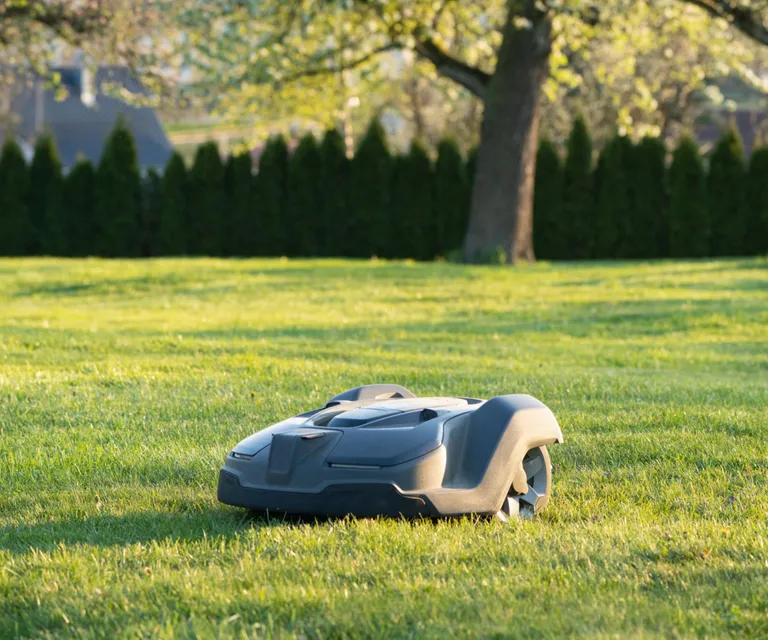Robot Lawn Mower Tips
Last Updated on July 17, 2025 by Duncan
If you own a robot lawnmower, you want to get the best experience and results from it, right? It’s possible with these tips:
Use high-quality blades
Dull blades pull the lawn rather than cutting it. And you don’t want this. This is because this neither looks good nor is healthy for the lawn. For a great experience, you need to ensure that the blades are constantly sharp.
You can accomplish this by constantly using high-quality blades rather than low-cost items that dull after a few uses. Dull blades also generate more noise while mowing. You should keep your knives sharp because:
- Blunt blades pull rather than cut
- Plucked lawns do not look good.
- Repeated usage of dull blades causes long-term harm to the lawn and deteriorates its attractiveness.
- Dull blades cause the mower to become noisier.
Stainless steel blades with a titanium coating are especially durable, lasting between 200 and 250 mowing hours.
While this is the case, you should note that the rate at which the blades wear out is also determined by the type of grass, the state of the ground, and any foreign items that may get beneath the mower.
For a great time, replace the blades regularly. How frequently you do it depends on the criteria listed above. Most manufacturers recommend replacing blade discs every one to three months.
In contrast, star-shaped mowing crosses only need to be replaced once a season. The following elements affect the life of the blades:
- Objects lying around, such as fallen fruit, pine cones, and stones.
- Protruding tree roots.
- The grass variety (strong variants mean rapid dulling)
- The quality of blades
- The soil qualities (e.g., sandy soil means rapid drying).
Remove objects from your lawn.
As mentioned, things lying about on the grass can have a detrimental impact on the blades of your robotic mower.
On newer mowers with blade discs, the blades give way on hard objects to avoid snapping, yet they still wear out. Other robotic mowers with mowing crosses may break down if you drive over larger stones.
While this is the case, even “harmless” objects like fallen fruit, black walnuts, pine cones, and tree roots wear down the blades more quickly.
The blades do not break, but because they are rather hard, they quickly get dull. You wouldn’t use a kitchen knife to cut wood, right?
But that’s not all: the mower’s engine suffers if items get into the mower and cause the rotor to stall.
In addition to this, if the robotic mower is required to perform an extremely difficult job, the battery will deplete faster. This can result in having too many leaves on the grass. Removing things from the lawn before mowing has the following benefits:
- Protects the robotic mower from damage.
- Less wear on the blades
- Reduced wear on the mower motor.
- Less wear and tear on the battery (the robotic mower must travel to the charging station less frequently).
Be cautious when mowing slopes.
Slopes in the yard are, in theory, no problem as long as you pay attention to a few details. First and foremost, ensure that the robotic mower is constructed for the grade of your lawn.
Cheaper models can often only handle gradients of up to 25%. Husqvarna machines, on the other hand, frequently handle grades of up to 45%.
Ensure that your robotic mower is designed for the slope; otherwise, its engine power would be insufficient to ascend the hill, and it may topple over while driving up.
Even if the robotic mower is designed for the slope, you should know that issues can arise. One is that the wheels can turn.
This can happen, especially in damp weather. When the wheels spin, the turf is harmed, resulting in furrows or bare patches on the lawn.
A so-called terrain kit can help in this situation. The terrain kit’s wheels feature a deeper tread, providing additional grip for the robotic mower. This is an effective approach to keep the wheels from rotating.
Furthermore, on steep slopes, the robotic mower may be unable to stop in time at a boundary wire and, as a result of the momentum gained while traveling downhill, shoot over it. Unfortunately, it cannot find its way back after this has occurred.
When laying the cable, if possible, ensure that there is a flat “run-out area” at the end of the cable, or, if that is not possible, that there is an obstruction to halt the robotic mower. In this instance, it is best to install a bumper, or guard, on the robotic mower.
To be on the safe side, avoid these mistakes on slopes.
- Having a robotic mower that is not intended for the gradient.
- Not employing a terrain kit in case of high inclines.
- Mowing while the grass on the slope is wet
Setting up your boundary wire to allow your robotic mower to shoot across it after descending the slope.
If you are thinking about obtaining a robotic mower that is specifically designed for slopes, take time to research the right unit to go for.
Don’t make mistakes when laying the boundary wire.
When putting the boundary wire, you need to consider a few factors to ensure that the robotic mower can mow the lawn effectively.
First, the boundary wire’s angles must not be too acute. Otherwise, the robotic mower will struggle to maneuver into tight corners. It is best to have gently rounded edges and, if possible, an angle of no less than 90 degrees.
You should also ensure that the boundary wire is not too close to a power cable. As with the boundary wire, the power cable generates an electromagnetic field.
This may anger the robotic lawnmower. As a result, it may be unable to access some areas of the lawn since it has already turned around.
If you have a lot of power wires running through the yard or under the surface that could potentially interfere with the robotic mower, such as on a roof terrace, it is also a good idea to use a robotic mower without a boundary wire.
To be on the safe side, keep the following points in mind when placing the boundary wire:
- No sharp angles below 90°
- Round off the corners slightly.
- Avoid laying wires near electricity cables.
If there are many power wires in the yard, consider choosing a robotic mower with no boundary wire.
Use your lawn mower on the right grass.
In principle, robotic mowers can be used on any lawn without issue. However, there are particular grass combinations that are designed for short mowing intervals and can handle them better.
These types absorb nutrients from lawn mulch more readily than traditional lawn varieties.
With the correct grass mixture, you create a lawn that is well-suited to the usage of a robotic mower and thrives especially well. The end effect is a well-kept, green, healthy lawn.
If you wish to install a new lawn, you should choose a unique form of lawn that can be maintained with robotic mowers. In some ways, this is the icing on the lawn care cake.
If you follow the other advice in this post and choose a robotic mower, you’ll soon have the greenest, most well-kept, and healthiest lawn you can imagine. The benefits of specialized grass varieties for robotic mowers:
- Improved compatibility with shorter mowing intervals
- Improved nutrient absorption from lawn mulch.
- Perfect harmony between the robotic mower and the lawn


